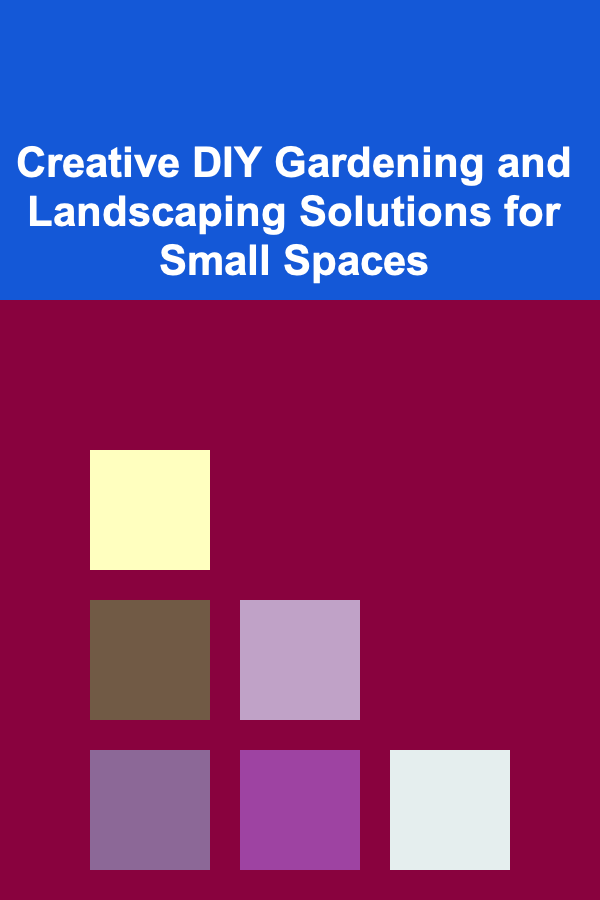
Creative DIY Gardening and Landscaping Solutions for Small Spaces
ebook include PDF & Audio bundle (Micro Guide)
$12.99$8.99
Limited Time Offer! Order within the next:

Gardening and landscaping can be incredibly rewarding, transforming any space into a vibrant, relaxing, and beautiful environment. However, if you're working with a small space, you may feel limited by the size of your garden or yard. Don't worry---small spaces can offer plenty of opportunities to create stunning outdoor areas with the right approach. With a little creativity and some clever DIY solutions, you can maximize the potential of your small garden and turn it into a peaceful oasis.
In this actionable guide, we'll explore a variety of creative and functional DIY gardening and landscaping ideas for small spaces, including vertical gardening, compact garden designs, and innovative landscaping tricks that make the most out of every inch of your space.
Embrace Vertical Gardening
When you have limited floor space, vertical gardening is a fantastic solution. Vertical gardening allows you to grow plants upwards rather than outwards, making it perfect for small yards, balconies, or even indoor spaces.
Actionable Steps:
- Install Vertical Plant Supports: Use trellises, plant walls, or shelving units to grow climbing plants like ivy, peas, tomatoes, or cucumbers. Install vertical plant supports along fences or walls to maximize space.
- Use Hanging Planters: Hanging baskets or wall-mounted planters are great for adding greenery without taking up valuable floor space. Consider hanging plants like ferns, petunias, or trailing ivy.
- Create a Living Wall: Turn one of your walls into a living garden by attaching small planters or pockets of soil for herbs, flowers, or succulents. You can make a vertical garden from pallets or buy ready-made systems to simplify the process.
- Vertical Herb Gardens: For kitchen gardens, create vertical herb planters using a variety of containers like gutters, mason jars, or even old shoes. You can hang these planters along fences or create a tower of herbs in your kitchen.
Key Considerations:
- Ensure the vertical garden gets enough sunlight for the plants you choose.
- Consider watering systems like drip irrigation or self-watering planters for easier maintenance.
Container Gardening
Container gardening is an excellent way to grow plants in small spaces, as it offers flexibility and the ability to move plants around. Whether you have a patio, balcony, or even a window ledge, you can create a thriving garden using containers of all shapes and sizes.
Actionable Steps:
- Choose the Right Containers: Select containers that suit the plants you want to grow. Larger containers are better for vegetables and shrubs, while smaller pots work well for flowers or herbs.
- Use Upcycled Materials: Get creative with containers by repurposing old items like buckets, wooden crates, or even old tires. This adds a unique touch to your garden and reduces waste.
- Create a Garden of Mixed Containers: Use a combination of containers of different shapes, colors, and sizes to create a more visually interesting display. You can also stack containers on top of each other to save floor space.
- Consider Mobility: For a flexible garden, use containers with wheels or create movable garden carts. This allows you to adjust your garden setup depending on the season or lighting changes.
Key Considerations:
- Make sure your containers have good drainage to prevent waterlogging.
- Choose plants that fit the size of the container to avoid overcrowding and ensure healthy growth.
Garden with a Purpose: Herb Gardens and Edible Landscapes
One of the best ways to make the most out of a small space is by creating a functional garden that serves both aesthetic and practical purposes. Herb gardens and edible landscaping are perfect for small spaces, as they don't require much room but offer immense benefits.
Actionable Steps:
- Plant Edible Plants in Containers: Herbs like basil, thyme, rosemary, and mint thrive in containers and are perfect for small gardens. You can grow them on a windowsill, balcony, or even within your vertical garden.
- Integrate Vegetables with Ornamental Plants: Consider using vegetables like peppers, tomatoes, or lettuce as ornamental plants. Many of these vegetables have attractive foliage or colorful fruits that can enhance the look of your garden.
- Create Raised Beds: Raised garden beds are perfect for growing vegetables, herbs, and flowers in small spaces. You can build your own raised beds using wooden planks, concrete blocks, or even repurposed materials like bricks.
- Interplant Flowers and Herbs: Many flowers like marigolds or nasturtiums are edible and add vibrant color to your garden. Interplanting these flowers with herbs or vegetables will enhance both the visual appeal and the utility of your garden.
Key Considerations:
- Ensure the plants you choose have similar sunlight and watering needs.
- Edible plants may require extra attention to pests, so be mindful of natural pest control methods like companion planting or organic sprays.
Utilize Clever Landscaping Ideas
Landscaping doesn't have to be limited to grass and shrubs. For small spaces, think outside the box by incorporating creative landscaping ideas that maximize both form and function.
Actionable Steps:
- Add a Gravel Path: If you have a small garden or yard, consider replacing part of the lawn with a gravel path or walkway. Gravel is inexpensive, easy to maintain, and can make your small space feel more expansive.
- Use Landscaping Rocks: Incorporate landscaping rocks or stones to create visual interest in your garden. Rocks can be used as borders, steps, or even as decorative elements in raised beds.
- Build a Mini Water Feature: Add a small fountain or birdbath to your garden for a calming effect. Water features work well in small spaces because they create a sense of movement and tranquility without taking up too much room.
- Create Garden Edges: Use edging materials like bricks, stones, or wooden planks to define areas within your garden. This can help separate different sections, like a seating area or vegetable garden, and give the space more structure.
Key Considerations:
- Choose landscaping materials that are in harmony with the plants in your garden.
- Incorporate texture into your landscape design by mixing smooth, rough, large, and small elements.
Maximize Vertical Surfaces: Walls, Fences, and Railings
Small spaces often have untapped vertical surfaces, such as walls, fences, or railings. These surfaces can be turned into stunning parts of your garden or landscape with a little creativity.
Actionable Steps:
- Use Fences for Climbing Plants: Install trellises or mesh wire along fences and plant climbing plants like roses, clematis, or morning glories. These plants add beauty and privacy without taking up valuable floor space.
- Create Green Railings: If you have a balcony or patio with railings, hang small pots or use a railing planter. You can grow flowers, succulents, or even strawberries in these planters.
- Paint Your Walls: Consider painting your walls a bright or earthy color to make the space feel more expansive. You can also create a mural or mosaic that complements the plants in your garden.
- Install Hanging Vertical Planters: Utilize the top portions of walls or fences by hanging vertical planters. These can hold a variety of plants, from flowers to succulents, and create a green backdrop in a small space.
Key Considerations:
- Ensure that vertical garden structures are secure and able to support the weight of plants.
- Be mindful of the maintenance required for vertical gardens, especially in areas with harsh weather conditions.
Conclusion
Creating a beautiful and functional garden in a small space is entirely possible with the right approach. By thinking creatively and incorporating vertical gardens, container plants, edible landscaping, and clever landscaping solutions, you can transform even the tiniest of spaces into a lush and inviting retreat. With the actionable steps and tips outlined in this guide, you're well on your way to designing a garden that is as beautiful as it is practical.
Remember, small spaces don't have to limit your gardening ambitions---they can enhance your creativity and allow you to experiment with new ideas. The key is to plan carefully, make the most of available space, and select plants and materials that fit your aesthetic and practical needs. Happy gardening!

How to Diversify Your Investment Portfolio for Maximum Growth
Read More
How to Plan and Organize a Successful Garage Sale
Read More
How to Save for Your Child's Education with a 529 Plan
Read More
How to Serve Delicious and Easy Party Snacks at Home
Read More
Mastering Performance Marketing Management: A Guide for Modern Marketers
Read More
Start Here: How to Start a Fitness Routine
Read MoreOther Products

How to Diversify Your Investment Portfolio for Maximum Growth
Read More
How to Plan and Organize a Successful Garage Sale
Read More
How to Save for Your Child's Education with a 529 Plan
Read More
How to Serve Delicious and Easy Party Snacks at Home
Read More
Mastering Performance Marketing Management: A Guide for Modern Marketers
Read More